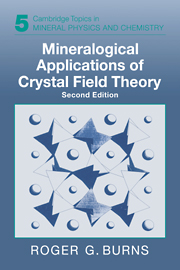Book contents
- Frontmatter
- Contents
- Preface to the first edition
- Preface to the second edition
- 1 Introduction
- 2 Outline of crystal field theory
- 3 Energy level diagrams and crystal field spectra of transition metal ions
- 4 Measurements of absorption spectra of minerals
- 5 Crystal field spectra of transition metal ions in minerals
- 6 Crystal chemistry of transition metal-bearing minerals
- 7 Thermodynamic properties influenced by crystal field energies
- 8 Trace element geochemistry: distribution of transition metals in the Earth's crust
- 9 Mantle geochemistry of the transition elements: optical spectra at elevated temperatures and pressures
- 10 Remote-sensing compositions of planetary surfaces: applications of reflectance spectra
- 11 Covalent bonding of the transition elements
- Appendices
- References
- Subject index
4 - Measurements of absorption spectra of minerals
Published online by Cambridge University Press: 23 November 2009
- Frontmatter
- Contents
- Preface to the first edition
- Preface to the second edition
- 1 Introduction
- 2 Outline of crystal field theory
- 3 Energy level diagrams and crystal field spectra of transition metal ions
- 4 Measurements of absorption spectra of minerals
- 5 Crystal field spectra of transition metal ions in minerals
- 6 Crystal chemistry of transition metal-bearing minerals
- 7 Thermodynamic properties influenced by crystal field energies
- 8 Trace element geochemistry: distribution of transition metals in the Earth's crust
- 9 Mantle geochemistry of the transition elements: optical spectra at elevated temperatures and pressures
- 10 Remote-sensing compositions of planetary surfaces: applications of reflectance spectra
- 11 Covalent bonding of the transition elements
- Appendices
- References
- Subject index
Summary
Since ferrous iron usually colors minerals green, and ferric iron yellow or brown, it may seem rather remarkable that the presence of both together should give rise to a blue color, as in the case of vivianite. – – Other instances may perhaps be discovered, should this subject ever be investigated as it deserves to be.
E. T. Wherry, Amer. Mineral, 3, 161 (1918)Introduction
In order to apply crystal field theory to geologic processes involving transition metal ions, it is necessary to have crystal chemical information and thermodynamic data for these cations in mineral structures. In 2.8, it was noted that the principal method for obtaining crystal field splittings, and hence stabilization energies of the cations, is from measurements of absorption spectra of transition metal compounds at wavelengths in the visible and near-infrared regions. The origins of such absorption bands in crystal field spectra were discussed in chapter 3. The focus of this chapter is on measurements of absorption spectra of minerals, with some applications to fundamental crystal chemical problems.
When minerals occur as large, gem-sized crystals, it is comparatively easy to obtain absorption spectra by passing light through natural crystal faces or polished slabs of the mineral. However, most rock-forming minerals are present in assemblages of very small crystals intimately associated with one another, leading to technical problems for measuring spectra of minerals in situ. In addition, several of the transition elements occur in only trace amounts in common minerals, making spectral features of individual cations difficult to resolve, especially in the presence of more abundant elements such as iron, titanium and manganese which also absorb radiation in the visible to nearinfrared region.
- Type
- Chapter
- Information
- Mineralogical Applications of Crystal Field Theory , pp. 87 - 145Publisher: Cambridge University PressPrint publication year: 1993

